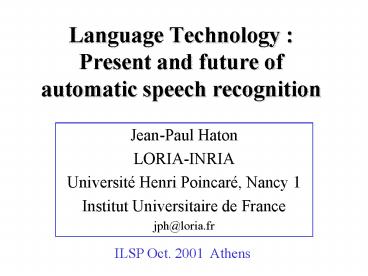Language Technology : Present and future of automatic speech recognition
1 / 20
Title:
Language Technology : Present and future of automatic speech recognition
Description:
Language Technology : Present and future of automatic speech ... Access to information: travel, banking, portals. Commands: avionics, automobile, etc. ... –
Number of Views:73
Avg rating:3.0/5.0
Title: Language Technology : Present and future of automatic speech recognition
1
Language Technology Present and future of
automatic speech recognition
- Jean-Paul Haton
- LORIA-INRIA
- Université Henri Poincaré, Nancy 1
- Institut Universitaire de France
- jph_at_loria.fr
ILSP Oct. 2001 Athens
2
Outline
- Evolution of ASR
- Basic principles
- A major problem robustness
- State of the art
- Future trends and perspectives
3
Applications of ASR
- Data entry voice dictation, etc.
- Access to information travel, banking, portals
- Commands avionics, automobile, etc.
- Speech transcription
- Handicapped
- Speech-to-speech translation
4
Speech recognition technology
5
Principle of Automatic Speech Recognition
6
Bayes Decision Rule
Speech
Parametrization
X x 1T
P(X/W)
Acoustic Models
Search max P(X/W) P(W) W w 1N
Language Models
P(W)
Word sequence
7
Speech modelized by HMMs
- The speech production process is supposed to be
Markovian
8
Robustness issues in ASR
- Mismatches between training and operating
conditions can lead to a significant loss in
performance
9
Main causes of acoustic variation in speech
10
Influence of noise on recognition
11
Approaches to robustness
- Three non-exclusive appoaches
- Signal acquisition and denoising
- Robust parameterization (less sensitive to noise
variations) - Model modification adaptation
12
Speech Parametrization
- Use of knowledge from perception,
psychoacoustics, neurology, etc. - ear models
- noise masking
- dynamic parameters
- analyses PLP, RASTA, RASTA-PLP, etc.
- Cepstral Normalization
13
Multibands recognition
14
Acoustic Model Adaptation
- Objective
- To derive a new set of models that better match
the operating environment - Principle
- To use a small amount of adaptation data
reflecting the operating environment to modify
the original models
15
Examples of adaptation methods
- Combination of models PMC (Parallel Model
Combination) - Linear transformations of models. Example MLLR
(Maximum Likelihood Linear Regression) - MAP (Maximum a posteriori) the a priori
probability - of models is not uniform
- Hybridations MLLR/MAP
- Model grouping into classes (eigenvoices, etc.)
- Non-linear transforms (neural networks, etc.)
16
Parallel Model Combination (PMC) Gales, 1995
17
MLLR example
i
u
u
i
a
18
MLLR speaker adaptation
19
State-of-the-art algorithms in speech recognition
Speech input
Acoustic analysis
Phoneme inventory
Pronunciation lexicon
Global search
Recognized Word sequence
20
Future research needs
- Better modelling of speech variability
- (structural and non-structural)
- Better knowledge on speech perception
- and adaptation by humans
- Beyond recognition speech understanding































